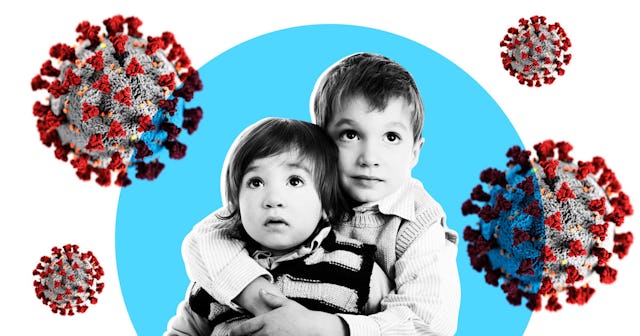If You Have Relaxed Your COVID-19 Precautions, Experts Say To Reel It In ASAFP

It has been a long, grueling six months. I don’t know about you, but I’m exhausted. I don’t just mean the kind of exhausted where you could crawl into bed and sleep for 14 hours straight either. I mean the kind of exhausted where you want to put your head in your hands and cry. Or scream. Or both.
Life is hard even under the best of circumstances. Add a global pandemic that has been exacerbated to horrific levels because of a complete lack of leadership and, well, that is next level awful.
Even still, I try to be a glass-half-full kind of person. I genuinely love my life. I enjoy spending time with my family. I have a cozy, albeit modest home. My family is healthy. And I actually enjoy time alone (or rather I despise large groups). So yeah, I’m grateful.
But, I’ll be honest, I’m already feeling scared and sad as we move into fall. Not because I don’t love sweater weather and PSL season – because I do – but because this year fall (and the dreaded winter) will mean even more isolation.
The past three to four months of social isolation and COVID safety measures have been manageable with the warmer weather. Neighborhood walks were a near-daily activity. My older son could go for bike rides with a few close friends. I was able to see my family and a few close friends a handful of times thanks to small, socially distanced and masked backyard barbeques. My kids could see their cousins here and there because, again, small outdoor activities were easy to manage.
But with the changing weather – at least for those of us in the northern half of the country – that is all about to slip away very soon. In fact, experts are already warning that we need to tighten up our pandemic bubbles – STAT.
“I think they shouldn’t have opened (social bubbles) to begin with,” Dr. Yvonne Maldonado, a professor of pediatrics and health research and policy at Stanford Health Care in California, told TODAY. “This is a time when we all want to see our family and friends, and we can still do that, but I think we just have to be very cautious about how and when and how many.”
Chris Clor/Getty
Add in cold and flu season, along with more kids attending in-person school, and we’ve got a recipe for a disaster.
Truth be told, lots of people have been getting a little loosey-goosey with their pandemic safety measures. Lots of folks have the “except for” mentality. You know, the “Our family is quarantining and super safe. Except for that family party last week and the grocery trips and eating at a restaurant a couple times and weekly walks with my neighbor and my kids going to daycare… except for all that, we don’t do go anywhere or do anything.”
All those “except for’s” increase risks, which are even more dangerous when they are done indoors.
“It’s going to be a lot harder to stay outdoors and try to socialize, and people are going to go inside,” Gregg Gonsalves, Ph.D., an assistant professor epidemiology at the Yale School of Public Health, told TODAY. “And as people go inside, that’s where risk increases.”
But quarantine fatigue is real, and there are mental health considerations to keep in mind. We aren’t meant to hard-core quarantine for months (or maybe even years) at a time. So it all comes down to risk management. Just like safe sex is more practical and as a result more effective than abstinence-only education, minimizing the risks of COVID all comes down to minimizing risky behaviors and making those risks we do take as a safe as possible.
“It’s basically impossible to live a zero-risk life,” Tara Kirk Sell, a professor at Johns Hopkins Bloomberg School of Public Health, acknowledged to ABC News. “An appropriate response to COVID is about shaping our risks and the risks we bring to others around us, within the context of our priorities and life situations…COVID-19 isn’t going away. We need to figure out how to manage the next year or more in responsible ways that still allow us to maintain the important components of our lives.”
While this is true, the key word is RESPONSIBLE. We can’t be careless or sloppy. We can’t let pandemic fatigue fool us into thinking things are safer than they are. The pandemic isn’t over, as much as we’d like to think it is.
“There is sort of a collective pandemic fatigue, like ‘We’ve been there, done that, now we’re on the other side.’ I would caution against that attitude,” Barun Mathema, Ph.D., an assistant professor of epidemiology at the Columbia University Mailman School of Public Health, told TODAY. “I don’t think we have enough evidence to say that we’re on the other side.”
Epidemiologists say there’s no one-size-fits-all approach into what’s considered safe. Mathema recommends that we examine local statistics, specifically rates of community transmission.
Bottom line: smaller groups and fewer interactions is safer. So take a good look at your “except for’s” and cut them down. Way down. Get strict about your safety measures, especially when it comes to socializing with family and friends. Just because someone is family doesn’t mean that they (or we) are safe.
We’re going to need to limit our in-public activities even more. Maybe that means cutting your grocery trips from once a week down to once every other week. Trim down your in-person social circle. You might need to choose between sending your kids to daycare or in-person school, and seeing your elderly parents. And FFS, wear a mask. All the damn time.
There’s no way to sugar-coat this, folks. Winter is coming, and it ain’t gonna be pretty or easy. But we can do this. Because we have to.
This article was originally published on